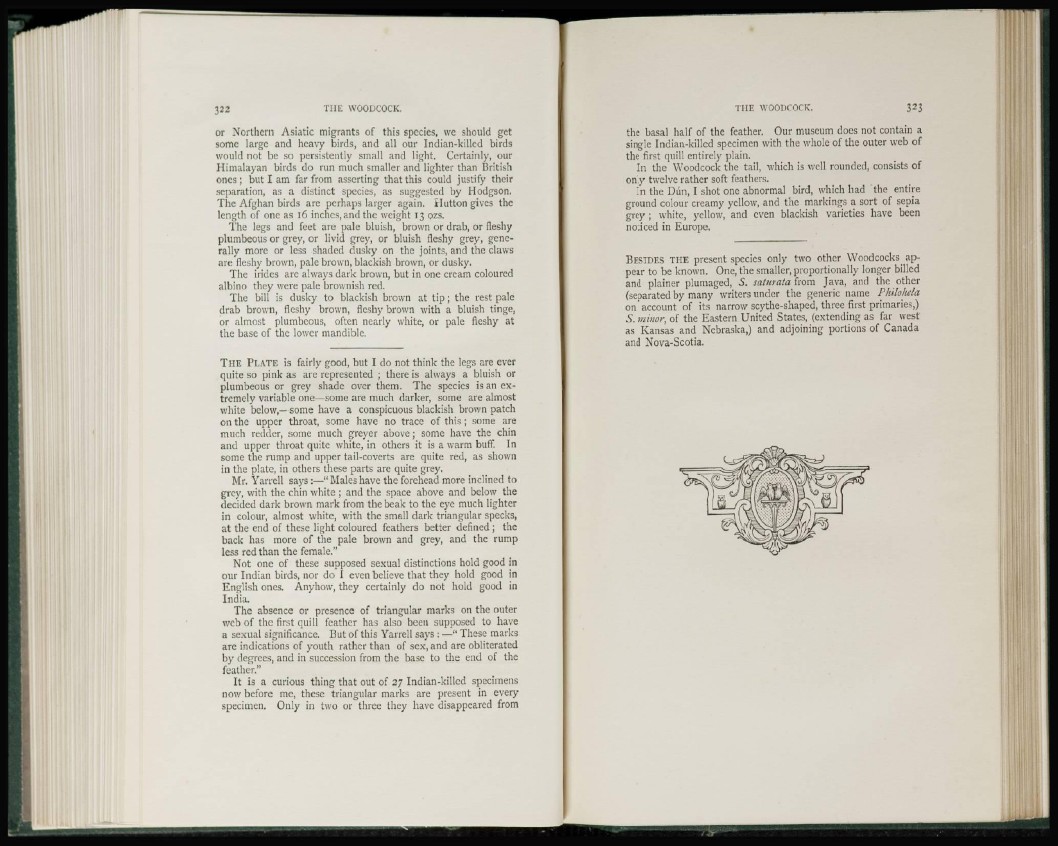
or Northern Asiatic migrants of this species, we should get
some large and heavy birds, and all our Indian-killed birds
would not be so persistently small and light. Certainly, our
Himalayan birds do run much smaller and lighter than British
ones; but I am far from asserting that this could justify their
separation, as a distinct species, as suggested by Hodgson.
The Afghan birds are perhaps larger again. Hutton gives the
length of one as 16 inches, and the weight 13 ozs.
The legs and feet are pale bluish, brown or drab, or fleshy
plumbeous or grey, or livid grey, or bluish fleshy grey, generally
more or less shaded dusky on the joints, and the claws
are fleshy brown, pale brown, blackish brown, or dusky.
The irides are always dark brown, but in one cream coloured
albino they were pale brownish red.
The bill is dusky to blackish brown at tip ; the rest pale
drab brown, fleshy brown, fleshy brown with a bluish tinge,
or almost plumbeous, often nearly white, or pale fleshy at
the base of the lower mandible.
THE PLATE is fairly good, but I do not think the legs are ever
quite so pink as are represented ; there is always a bluish or
plumbeous or grey shade over them. The species is an extremely
variable one—some are much darker, some are almost
white below,— some have a conspicuous blackish brown patch
on the upper throat, some have no trace of this ; some are
much redder, some much greyer above ; some have the chin
and upper throat quite white, in others it is a warm buff. In
some the rump and upper tail-coverts are quite red, as shown
in the plate, in others these parts are quite grey.
Mr. Yarrcll says :—" Males have the forehead more inclined to
grey, with the chin white ; and the space above and below the
decided dark brown mark from the beak to the eye much lighter
in colour, almost white, with the small dark triangular specks,
at the end of these light coloured feathers better defined; the
back has more of the pale brown and grey, and the rump
less red than the female."
Not one of these supposed sexual distinctions hold good in
our Indian birds, nor do I even believe that they hold good in
English ones. Anyhow, they certainly do not hold good in
India.
The absence or presence of triangular marks on the outer
web of the first quill feather has also been supposed to have
a sexual significance. But of this Yarrelt says : —• These marks
are indications of youth rather than of sex, and are obliterated
by degrees, and in succession from the base to the end of the
feather."
It is a curious thing that out of 27 Indian-killed specimens
now before me, these triangular marks are present in every
specimen. Only in two or three they have disappeared from
the basal half of the feather. Our museum does not contain a
single Indian-killed specimen with the whole of the outer web of
the first quill entirely plain.
In the Woodcock the tail, which is well rounded, consists of
only twelve rather soft feathers.
In the Dun, I shot one abnormal bird, which had the entire
ground colour creamy yellow, and the markings a sort of sepia
grey ; white, yellow, and even blackish varieties have been
noticed in Europe.
BESIDES THE present species only two other Woodcocks^ appear
to be known. One, the smaller, proportionally longer billed
and plainer plumaged, 5. saturata from Java, and the other
(separated by many writers under the generic name Philohela
on account of its narrow scythe-shaped, three first primaries,)
5. minor, of the Eastern United States, (extending as far west
as Kansas and Nebraska,) and adjoining portions of Canada
and Nova-Scotia.